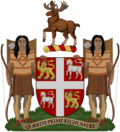Monarchy in Newfoundland and Labrador
| Queen in Right of Newfoundland and Labrador | |
|---|---|
|
Provincial/State
|
|

|
|
| Incumbent | |
 |
|
|
Elizabeth II Queen of Canada since 6 February 1952 |
|
| Details | |
| Style | Her Majesty |
| First monarch | George VI |
| Formation | 31 March 1949 |
| Residence | Government House, St. John's |
By the arrangements of the Canadian federation, the Canadian monarchy operates in Newfoundland and Labrador as the core of the province's Westminster-style parliamentary democracy. As such, the Crown within Newfoundland and Labrador's jurisdiction is referred to as the Crown in Right of Newfoundland and Labrador,Her Majesty in Right of Newfoundland and Labrador, or the Queen in Right of Newfoundland and Labrador. The Constitution Act, 1867, however, leaves many royal duties in Newfoundland and Labrador specifically assigned to the sovereign's viceroy, the Lieutenant Governor of Newfoundland and Labrador, whose direct participation in governance is limited by the conventional stipulations of constitutional monarchy.
The role of the Crown is both legal and practical; it functions in Newfoundland and Labrador in the same way it does in all of Canada's other provinces, being the centre of a constitutional construct in which the institutions of government acting under the sovereign's authority share the power of the whole. It is thus the foundation of the executive, legislative, and judicial branches of the province's government. The Canadian monarch—since 6 February 1952, Queen Elizabeth II—is represented and her duties carried out by the Lieutenant Governor of Newfoundland and Labrador, who's direct participation in governance is limited by the conventional stipulations of constitutional monarchy, with most related powers entrusted for exercise by the elected parliamentarians, the ministers of the Crown generally drawn from amongst them, and the judges and justices of the peace. The Crown today primarily functions as a guarantor of continuous and stable governance and a nonpartisan safeguard against the abuse of power. This arrangement began with the granting in 1949 of Royal Assent to the Newfoundland Act and continued an unbroken line of monarchical government extending back to the late 15th century. However, though Newfoundland and Labrador has a separate government headed by the Queen, as a province, Newfoundland and Labrador is not itself a kingdom.
...
Wikipedia
